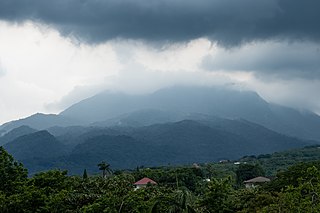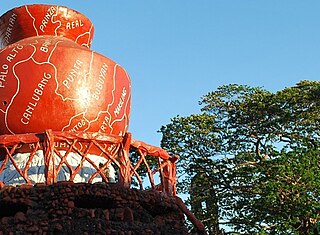
Laguna, officially the Province of Laguna, is a province in the Philippines located in the Calabarzon region in Luzon. Its capital is Santa Cruz while its largest city is the City of Calamba and the province is situated southeast of Metro Manila, south of the province of Rizal, west of Quezon, north of Batangas and east of Cavite. Laguna hugs the southern shores of Laguna de Bay, the largest lake in the country. As of the 2020 census, the province's total population is 3,382,193. It is the seventh richest province in the country.

Calabarzon, also known as Southern Tagalog and designated as Region IV‑A, is an administrative region in the Philippines. The region comprises five provinces: Batangas, Cavite, Laguna, Quezon, and Rizal; and one highly urbanized city, Lucena. It is the most populous region in the Philippines according to the Philippine Statistics Authority (PSA), having over 16.1 million inhabitants in 2020, and is also the country's second most densely populated after the National Capital Region. It is situated southeast of Metro Manila, and is bordered by Manila Bay to the west, Lamon Bay and the Bicol Region to the east, Tayabas Bay and the Sibuyan Sea to the south, and Central Luzon to the north. It is home to places like Mount Makiling near Los Baños, Laguna, and Taal Volcano in Batangas.

Laguna de Bay, also known as Laguna Lake, is the largest lake in the Philippines. It is located southeast of Metro Manila, between the provinces of Laguna to the south and Rizal to the north. A freshwater lake, it has a surface area of 911–949 km², with an average depth of about 2.8 meters and an elevation of about one meter above sea level. The lake is shaped like a crow's foot, with two peninsulas jutting out from the northern shore and filling the large volcanic Laguna Caldera. In the middle of the lake is the large island of Talim.

San Pablo, officially the City of San Pablo, is a 1st class component city in the province of Laguna, Philippines. According to the 2020 census, it has a population of 285,348 people.

Los Baños, officially the Municipality of Los Baños, colloquialy 'elbi' or simply LB, is a 1st class municipality in the province of Laguna, Philippines. According to the 2020 census, it has a population of 115,353 people.

Calamba, officially the City of Calamba, is a 1st class component city in the province of Laguna, Philippines. According to the 2020 census, it has a population of 539,671 people.

Calauan, officially the Municipality of Calauan, is a 2nd class municipality in the province of Laguna, Philippines. The municipality has a land area of 25.25 square miles which constitutes 3.41% of Laguna's total area. According to the 2020 census, it has a population of 87,693 people.

Mount Makiling is an inactive stratovolcano located in the provinces of Laguna and Batangas on the island of Luzon in the Philippines. The mountain rises to an elevation of 1,090 m (3,580 ft) above mean sea level and is the highest feature of the Laguna Volcanic Field. The volcano has no recorded historic eruption but volcanism is still evident through geothermal features like mud spring and hot springs. South of the mountain is the Makiling-Banahaw Geothermal Plant. The Philippine Institute of Volcanology and Seismology (PHIVOLCS) classifies the volcano as "Inactive".

Maria Makiling, more properly Mariang Makiling, is a diwata (anito) or lambana (fairy) in Philippine mythology, associated with Mount Makiling in Laguna, Philippines. She is the most widely known diwata in Philippine mythology and was venerated in pre-colonial Philippines as a goddess known as Dayang Masalanta or Dian Masalanta who was invoked to stop deluges, storms, and earthquakes.

The National Arts Center is a building complex situated in Mount Makiling, Los Baños, Laguna, the Philippines. The establishment was inaugurated in 1976. Its theater is the Tanghalang Maria Makiling or the NAC Center, which has an audience capacity of 1,000 people.

The University of the Philippines Los Baños College of Forestry and Natural Resources is one of the 11 degree-granting units of the University of the Philippines Los Baños (UPLB). It started as the Forest School under the UP College of Agriculture in 1910, making it the oldest forestry school in the Philippines. It is one of the five founding units of UPLB upon its establishment in 1972.

The Molawin River, also referred to as the Molawin Creek, is one of the many low volume flowing rocky streams crisscrossing the campus of the University of the Philippines Los Baños and some areas of the town of Los Baños. Molawin Creek crosses the whole of the UPLB campus and essentially cuts it in half making it necessary to construct several bridges throughout the university's history to improve the campus' integrity and general accessibility. Volume of flow depends on the average rainfall of the season and develops into a raging river during typhoons or heavy rainfall. It is a minor tributary of Laguna Lake, one among many small creeks that empty into Laguna de Bay. The origins of Molawin Creek and the other creeks in Los Baños have not been pinpointed but are generally accepted to have their origins high up in Mount Makiling. The name Molawin is a local variation of the name of the Molave tree.

The 10th World Scout Jamboree was held 17–26 July 1959 and was hosted by the Philippines at Mount Makiling, Los Baños, Laguna. Dubbed "The Bamboo Jamboree" due to the prevalence of bamboo and nipa palm. There were a total 12,203 Scouts from 44 countries. The theme was "Building Tomorrow Today". It was the first World Scout Jamboree to be held in Asia, and as well outside Europe and Canada.

The main campus of University of the Philippines Los Baños (UPLB) is located in the towns of Los Baños and Bay in the province of Laguna, 64 km (40 mi) southeast of Manila. The complex covers 5,445 ha of land encompassing the entire Makiling Forest Reserve (MFR) and surrounding areas. Its land grants in the provinces of Laguna, Negros Occidental, and Quezon have a combined area of 9,760 ha. The Total Campus Area (Rural) 15,205 ha.
The Seven Lakes of San Pablo are seven volcanic crater lakes scattered around the City of San Pablo, in the province of Laguna, Philippines.

The Lyceum of the Philippines University – Laguna, one of the campuses of the Lyceum of the Philippines University, is an institute of higher education located in Km. 54, Brgy. Makiling, Calamba in the province of Laguna, Philippines. It was founded by Senator Sotero H. Laurel on January 18, 2000 as the third campus of the LPU system after Manila and Batangas.

Mount Sungay, also known as Mount Gonzales, is a mountain in the province of Cavite in the Philippines. Located in eastern Tagaytay, the inactive stratovolcano is the highest point in the province of Cavite, at 709 metres. The slopes of the mountain are the source of the San Cristobal River that flows from the mountain to Silang, Cavite down to its mouth at Laguna de Bay in Calamba, Laguna.
The Iglesia Watawat Ng Lahi, Inc. is a socio-folk religious group based on Lecheria Hill in Calamba, Laguna, Philippines which believes in the divinity of José Rizal, a historic figure of the Philippine Revolution. It is often considered as the original Rizalist group among the many other Rizalista religious movements.

The UPLB Museum of Natural History is a natural science and natural history museum within the University of the Philippines Los Baños (UPLB) campus. It serves as a center for documentation, research, and information of flora and fauna of the Philippines. The museum is one of the research and extension units of the UPLB and its role parallels that of a library for written records.




















